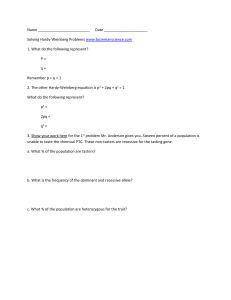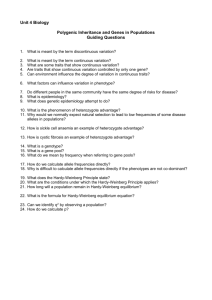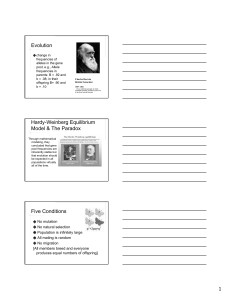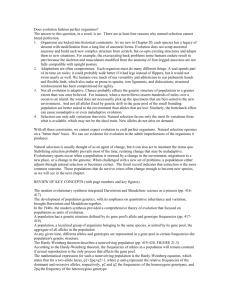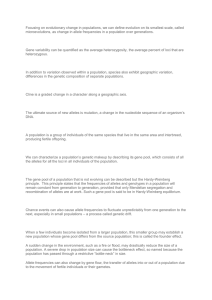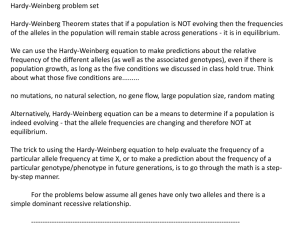Hardy-Weinberg
advertisement
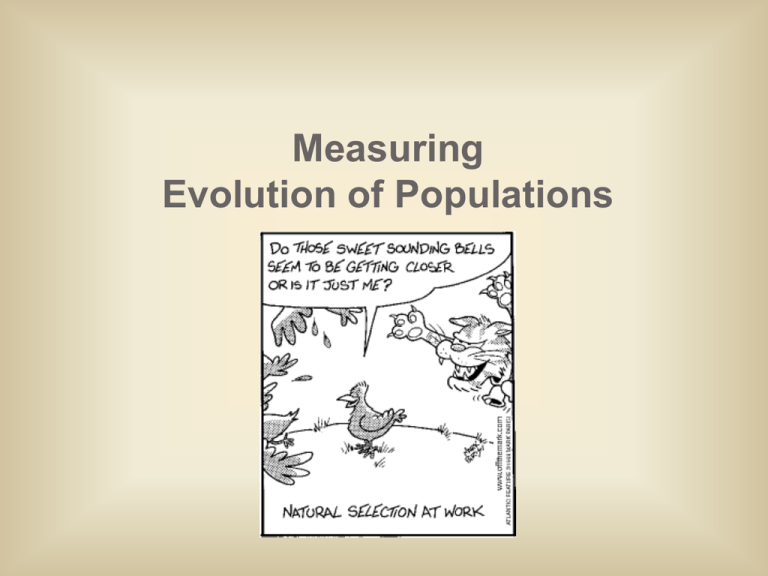
Measuring Evolution of Populations Gene Variation is Raw Material Evolution - change over time Evolution is descent with modification Darwin Through time, species accumulate differences such that ancestral and descendent species are not identical. Gene Variation is Raw Material Natural selection and evolutionary change Some individuals in a population possess certain inherited characteristics that play a role in producing more surviving offspring than individuals without those characteristics. The population gradually includes more individuals with advantageous characteristics. Darwin versus Lamarck Macroevolution It is large evolutionary change Evolution of new species from a common ancestor Evolution of one species into two or more species Microevolution Evolution on a small scale Is the change in gene frequencies within a population over time As the changes in populations accumulate, they can lead to the formation of new species. Populations & gene pools Concepts a population is a localized group of interbreeding individuals gene pool is collection of alleles in the population remember difference between alleles & genes! allele frequency is how common is that allele in the population how many A vs. a in whole population Hardy-Weinberg Principle Hardy-Weinberg - original proportions of genotypes in a population will remain constant from generation to generation Sexual reproduction (meiosis and fertilization) alone will not change allelic (genotypic) proportions. Hardy-Weinberg Principle Necessary assumptions Allelic frequencies would remain constant if… population size is very large random mating no mutation no gene input from external sources no selection occurring Hardy-Weinberg theorem Counting Alleles assume 2 alleles = B, b frequency of dominant allele (B) = p frequency of recessive allele (b) = q frequencies must add to 1 (100%), so: p+q=1 BB Bb bb Hardy-Weinberg theorem Counting Individuals frequency of homozygous dominant: p x p = p2 frequency of homozygous recessive: q x q = q2 frequency of heterozygotes: (p x q) + (q x p) = 2pq frequencies of all individuals must add to 1 (100%), so: p2 + 2pq + q2 = 1 BB Bb bb H-W formulas Alleles: p+q=1 B b p2 + 2pq + q2 = 1 Individuals: BB BB Bb Bb bb bb Using Hardy-Weinberg equation population: 100 cats 84 black, 16 white How many of each genotype? p2=.36 BB q2 (bb): 16/100 = .16 q (b): √.16 = 0.4 p (B): 1 - 0.4 = 0.6 2pq=.48 Bb q2=.16 bb Must is in H-W equilibrium! Whatassume are thepopulation genotype frequencies? Using Hardy-Weinberg equation p2=.36 Assuming H-W equilibrium 2pq=.48 q2=.16 BB Bb bb p2=.20 =.74 BB 2pq=.64 2pq=.10 Bb q2=.16 bb Null hypothesis Sampled data How do you explain the data? Application of H-W principle Sickle cell anemia inherit a mutation in gene coding for hemoglobin oxygen-carrying blood protein recessive allele = HsHs normal allele = Hb low oxygen levels causes RBC to sickle breakdown of RBC clogging small blood vessels damage to organs often lethal Sickle cell frequency High frequency of heterozygotes 1 in 5 in Central Africans = HbHs unusual for allele with severe detrimental effects in homozygotes 1 in 100 = HsHs usually die before reproductive age Why is the Hs allele maintained at such high levels in African populations? Suggests some selective advantage of being heterozygous… Malaria Single-celled eukaryote parasite (Plasmodium) spends part of its life cycle in red blood cells 1 2 3 Heterozygote Advantage In tropical Africa, where malaria is common: homozygous dominant (normal) die of malaria: HbHb homozygous recessive die of sickle cell anemia: HsHs heterozygote carriers are relatively free of both: HbHs survive more, more common in population Hypothesis: In malaria-infected cells, the O2 level is lowered enough to cause sickling which kills the cell & destroys the parasite. Frequency of sickle cell allele & distribution of malaria Hardy-Weinberg equilibrium Hypothetical, non-evolving population preserves allele frequencies Serves as a model (null hypothesis) natural populations rarely in H-W equilibrium useful model to measure if forces are acting on a population measuring evolutionary change G.H. Hardy mathematician W. Weinberg physician Evolution of populations Evolution = change in allele frequencies in a population hypothetical: what conditions would cause allele frequencies to not change? non-evolving population REMOVE all agents of evolutionary change 1. very large population size (no genetic drift) 2. no migration (no gene flow in or out) 3. no mutation (no genetic change) 4. random mating (no sexual selection) 5. no natural selection (everyone is equally fit) http://nhscience.lonestar.edu/biol/hwe.html 5 Agents of evolutionary change Mutation Gene Flow Non-random mating Genetic Drift Selection 5 Agents of evolutionary change 2005-2006 Five Agents of Evolutionary Change Mutation Mutation rates are generally so low they have little effect on Hardy-Weinberg proportions of common alleles. ultimate source of genetic variation Gene flow movement of alleles from one population to another tend to homogenize allele frequencies Five Agents of Evolutionary Change Nonrandom mating assortative mating - phenotypically similar individuals mate Causes frequencies of particular genotypes to differ from those predicted by Hardy-Weinberg. Five Agents of Evolutionary Change Genetic drift – statistical accidents. Frequencies of particular alleles may change by chance alone. important in small populations founder effect - few individuals found new population (small allelic pool) bottleneck effect - drastic reduction in population, and gene pool size Genetic Drift - Bottleneck Effect Five Agents of Evolutionary Change Selection – Only agent that produces adaptive evolutionary change artificial - breeders exert selection natural - nature exerts selection variation must exist among individuals variation must result in differences in numbers of viable offspring produced variation must be genetically inherited natural selection is a process, and evolution is an outcome Five Agents of Evolutionary Change Selection pressures: avoiding predators matching climatic condition pesticide resistance Measuring Fitness Fitness is defined by evolutionary biologists as the number of surviving offspring left in the next generation. relative measure Selection favors phenotypes with the greatest fitness. Interactions Among Evolutionary Forces Levels of variation retained in a population may be determined by the relative strength of different evolutionary processes. Gene flow versus natural selection Gene flow can be either a constructive or a constraining force. Allelic frequencies reflect a balance between gene flow and natural selection. Natural Selection Can Maintain Variation Frequency-dependent selection Phenotype fitness depends on its frequency within the population. Negative frequency-dependent selection favors rare phenotypes. Positive frequency-dependent selection eliminates variation. Oscillating selection Selection favors different phenotypes at different times. Forms of Selection Disruptive selection Selection eliminates intermediate types. Directional selection Selection eliminates one extreme from a phenotypic array. Stabilizing selection Selection acts to eliminate both extremes from an array of phenotypes. Sexual Selection Kinds of Selection Sexual selection Favours the selection of any trait that confers an advantage in terms of the mating success of the individual This is associated with sexual dimorphism: which is the physical (often extreme) differences in the appearance of males and females The most common forms of sexual selection are the results of female mate choice and male to male competition Sexual selection Females can chose based on physical traits, colouration, or behavioural traits such as courtship displays and songs Sometimes males develop features that enable them to establish and defend a territory from other males=sometimes detaining the females How would you be able to tell these are not env’tal selective pressures? Both sexes would possess the features. Sexual selection Some features are a compromise between mating and remaining conspicuous to predators==bright colours and song. What about plants? Sexual diversity is not limited to just animals Plants do not select mates but they do need to attract suitors to assist in pollination Flowers and scents are the most obvious examples of sexual features that have evolved==maximize pollination Selection on Color in Guppies Guppies are found in small northeastern streams in South America and in nearby mountainous streams in Trinidad. Due to dispersal barriers, guppies can be found in pools below waterfalls with high predation risk, or pools above waterfalls with low predation risk. Evolution of Coloration in Guppies Selection on Color in Guppies High predation environment - Males exhibit drab coloration and tend to be relatively small and reproduce at a younger age. Low predation environment - Males display bright coloration, a larger number of spots, and tend to be more successful at defending territories. In the absence of predators, larger, more colorful fish may produce more offspring. Evolutionary Change in Spot Number Limits to Selection Genes have multiple effects Pleiotropy - ex. PKU Evolution requires genetic variation Intense selection may remove variation from a population at a rate greater than mutation can replenish. thoroughbred horses Gene interactions affect allelic fitness epistatic interactions –ex.You may have a widows peak but if you have the baldness gene you will not see your widows peak. Any Questions?? 2005-2006
